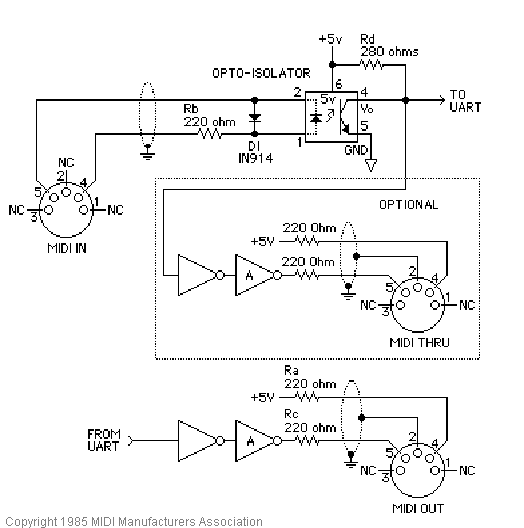Difference between revisions of "Inter-Device Communication"
Wikimaster (Talk | contribs) |
|||
| (5 intermediate revisions by one other user not shown) | |||
| Line 14: | Line 14: | ||
[http://www.harmony-central.com/MIDI/Doc/doc.html Harmony Central's MIDI Documentation] | [http://www.harmony-central.com/MIDI/Doc/doc.html Harmony Central's MIDI Documentation] | ||
| + | |||
| + | [http://www.tigoe.net/pcomp/midi.shtml Tom Igoe's MIDI Page] | ||
<center> | <center> | ||
| Line 22: | Line 24: | ||
==Serial== | ==Serial== | ||
| + | |||
| + | [http://www.tigoe.net/pcomp/serial.shtml Tom Igoe's Serial Communication Page]: Code examples related to BasicX, general serial communication overview. | ||
==USB== | ==USB== | ||
| + | |||
| + | [http://www.ftdichip.com/Products/FT232R.htm FTDI FT232R] The devices that supports RS-232 serial communication over USB on the AVRmini v4.0 | ||
==Wireless== | ==Wireless== | ||
| + | |||
| + | [http://www.procyonengineering.com/avr/boards/index.html AVRLinx]: Application board by Pascal Stang ([http://www.procyonengineering.com Procyon Engineering]) for 315/418/433MHz Wireless using Atmel AVR and Linx transcievers. | ||
| + | |||
| + | ===Infra-Red=== | ||
| + | ===Consumer Wireless RS-232=== | ||
| + | ===Bluetooth=== | ||
| + | ===802.11x=== | ||
| + | |||
| + | |||
| + | [[Category:PID]][[Category:PID_2007]] | ||
Latest revision as of 13:18, 13 August 2007
Contents
Open Sound Control (OSC)
Open Sound Control in a protocol developed at CNMAT for controlling sound synthesis applications. It can be used simply as a replacement for midi with meaningful message names that are easy to parse out in Max/MSP or Pd. It can also be used to create a heirarchy of message that are bound for different receivers and provides support for discovering the messages an application knows how to respond to.
Open Sound Control Homepage
Open Sound Control Specification
MIDI
MIDI - Music Instrument Digital Interface, is the result of a music industry effort to standardize the control communication between digital music instruments. MIDI in designed to be compact and easily parsed by machines (not humans!). MIDI messages are independant of timbre and describe only musical events such as note ons, note offs, [and pitch bends. MIDI also provides message to change the setup of remote instruments via control change messages. Today MIDI is used everywhere from cell phone rings to controlling theatre lights and interactive art installations.
MIDI has some serious drawbacks in bandwidth/speed, resolution and reliability of computer interface hardware/software. While it's not the only solution to instrument - computer communication, it is still an appropritate choice for many applications.
The MIDI Specification
Harmony Central's MIDI Documentation
Serial
Tom Igoe's Serial Communication Page: Code examples related to BasicX, general serial communication overview.
USB
FTDI FT232R The devices that supports RS-232 serial communication over USB on the AVRmini v4.0
Wireless
AVRLinx: Application board by Pascal Stang (Procyon Engineering) for 315/418/433MHz Wireless using Atmel AVR and Linx transcievers.
